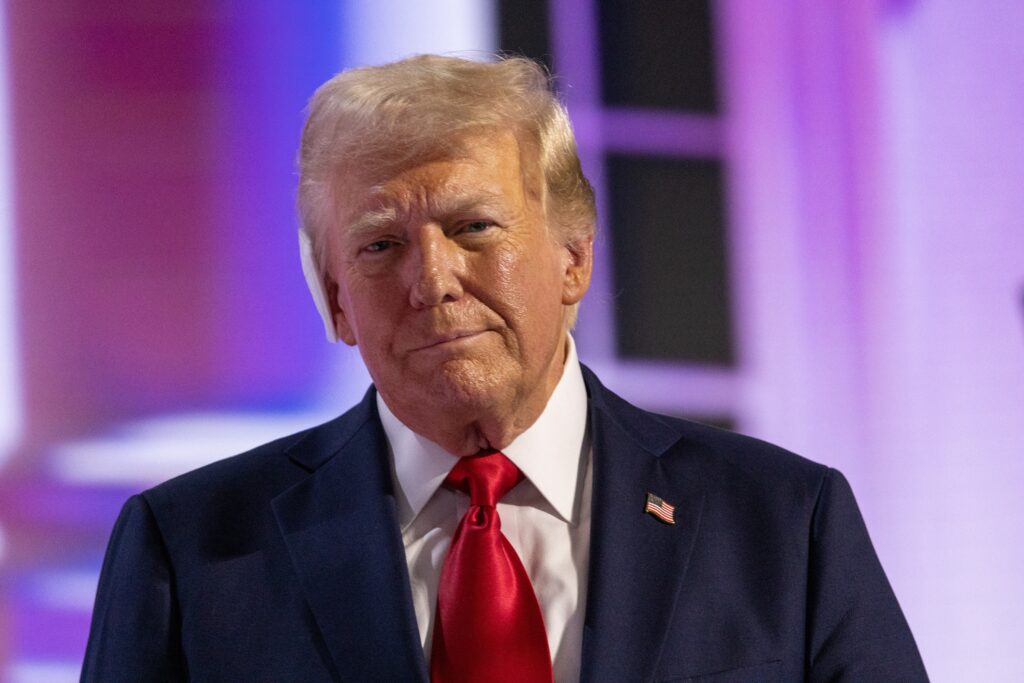Financial market trends Trump: Since Donald Trump took office, financial markets have experienced several notable shifts. Euronews Business reviews the major trends in asset classes over the past month, focusing on how investors have responded to Trump’s policies.
A Month of Change
It has now been a month since Donald Trump returned to the White House. As expected, he quickly got to work on his campaign promises. These include imposing tariffs, reducing federal workers, and initiating peace talks with Ukraine. The long-term impact of these policies remains uncertain, but the immediate market movements suggest how investors are reacting.
US Dollar Weakens – Financial market trends Trump
The US dollar had been on the rise after Trump’s election victory last year. It peaked in early January, but since his inauguration on January 20, the dollar index (DXY) has fallen by 2.2%, dropping from over 109 to 107 by February 19.
Several factors have contributed to this decline. First, markets had already priced in a strong dollar ahead of Trump’s inauguration, which led to profit-taking. Second, Trump postponed tariffs on Canada and Mexico, as well as duties on global trade partners. He did announce a 25% tariff on steel and aluminum, potentially extending to car manufacturers, semiconductor firms, and pharmaceuticals, but these will not take effect until April. The only immediate action has been a 10% tariff on China, which prompted swift countermeasures from the country.
Concerns about rapid inflation have also eased, reversing the dollar’s earlier gains. US government bond yields have also dropped due to the same reasons. Furthermore, the Federal Reserve signaled a possible slowdown in reducing its balance sheet, citing debt ceiling limits. The rising levels of government debt may keep borrowing costs elevated, further pressuring the dollar.
Stock Markets at Record Levels
Global stock markets have surged since Trump’s return to power. European stock markets, in particular, have led this rally. The delay in broad tariffs has likely boosted investor confidence. Key drivers of this market growth include expectations of lower global interest rates, excitement around artificial intelligence (AI), and strong corporate earnings. Trump’s peace talks with Russia have also given a boost to European defense stocks.
Across Europe, stock markets have seen broad-based gains, with every sector rising over the past month. The European Central Bank is expected to continue reducing interest rates, and it might even introduce specialized defense funding, which has fueled optimism.
Trump’s policies have also indirectly benefited several European sectors, including financial, technology, and industrial. His commitment to investing $500 billion (€479 billion) in US AI infrastructure, deregulating the banking industry, and encouraging higher EU defense spending has had a positive impact on market performance.
Gold Prices Soar – Financial market trends Trump
Gold has performed exceptionally well since Trump’s inauguration, with futures rising 8%. Increased demand for safe-haven assets reflects growing concerns about trade wars and potential economic slowdowns. The weaker US dollar has also contributed to gold’s upward trend.
Trump’s decision to cut thousands of federal jobs, with some help from Elon Musk, has fueled fears of higher unemployment and weaker consumer spending. These concerns have created market uncertainty, but they’ve also been a factor in driving gold’s strong performance.
Kyle Rodd, a senior market analyst at Capital.com, noted, “So far, these moves have disrupted the markets and brought upside risks to inflation. In the longer term, this could affect growth.” He further added that the approach of cutting jobs could impact employment and spending in the country.
Falling Oil Prices
Crude oil prices have been on a downward trajectory since Trump’s inauguration. Brent crude futures have fallen by 6.6%, while WTI futures have dropped 7.8%. This aligns with Trump’s goal to lower global oil prices. He has encouraged producers to increase supply, often using the slogan “Drill, baby, drill.”
Trump’s peace negotiations with Russia may include lifting sanctions on Russian oil exports. He has argued that cheaper energy would counterbalance the inflation caused by his new tariffs. However, it remains unclear if these plans will materialize.
Bitcoin Trades Sideways
Bitcoin, on the other hand, has seen a 4% drop since Trump’s return to office. Initial optimism about his promise to make America “a crypto capital” has faded.
The lack of clear policy direction may be one of the reasons for Bitcoin’s lackluster performance. Although Trump has proposed evaluating a “national digital asset stockpile,” he has not confirmed plans for a Bitcoin reserve. This has likely disappointed many cryptocurrency investors.
In summary, since Donald Trump took office, the financial markets have shown mixed results. The US dollar has weakened, stock markets have surged, gold has risen, and oil prices have fallen. Bitcoin has faced some challenges, and concerns over inflation and unemployment have created uncertainty. Trump’s policies, such as tariffs, peace talks, and deregulation, have influenced these market movements. Investors are closely watching his next moves, as the true impact of his policies continues to unfold.
For further updates on financial market trends and policy changes, visit Euro News 24.
